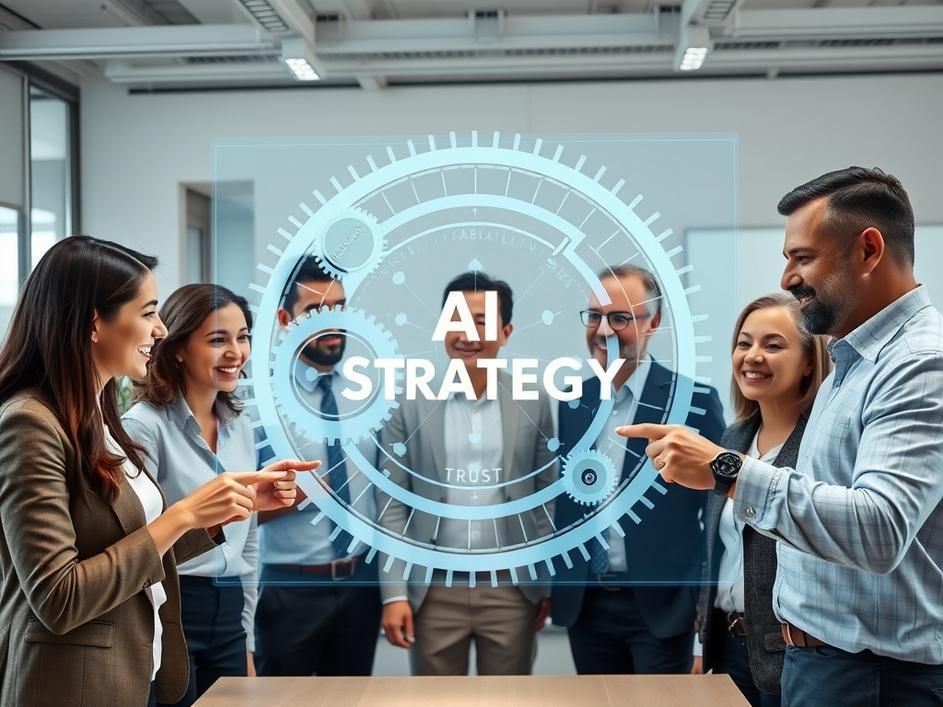


We are a digital agency helping businesses develop immersive, engaging, and user-focused web, app, and software solutions.
2310 Mira Vista Ave
Montrose, CA 91020
2500+ reviews based on client feedback

What's Included?
ToggleThere’s a lot of buzz about artificial intelligence right now. Every business leader hears about it, and it feels like everyone is jumping on board. It’s easy to get caught up in the excitement and think, “We need AI, and we need it now!” This rush often makes companies skip a crucial step: figuring out what problem they’re actually trying to solve. They might see a cool new AI tool and try to find a place for it, instead of starting with a clear business challenge and asking how AI could genuinely help. It’s like buying a fancy hammer before you even know if you need to build something or fix anything. This backwards approach can lead to a lot of wasted time, money, and effort. It can also create solutions that don’t quite fit, or even worse, cause new problems. Businesses are built on solving needs, and AI should be no different. Before even looking at a single algorithm or software, the first question should always be, “What pain point are we trying to ease for our customers or our team?” Getting this clear vision from the start is not just a nice-to-have; it’s the bedrock for any successful AI project. Without it, you’re just guessing, and that’s a risky game to play with technology that changes so fast.
So, why is it so important to define the problem first? Well, imagine building a house without blueprints. You might end up with walls that don’t connect, or rooms that don’t make sense. AI is similar. If you don’t know exactly what you’re aiming for, your AI solution might be powerful, but it won’t be useful. It could be brilliant at predicting things no one cares about, or automating tasks that aren’t bottlenecks. When you pinpoint the specific challenge – maybe it’s streamlining customer service, making supply chains smoother, or spotting fraud faster – you give your AI a clear target. This clarity helps you pick the right kind of AI, choose the right data, and set realistic expectations. It also means you can measure success properly. Did the AI actually improve customer wait times by X percent? Did it cut down on manual data entry errors? When you start with the problem, every decision about the AI solution becomes clearer and more focused. You avoid the trap of “solutionism,” where you have a cool piece of tech and try to force it into situations where it doesn’t really belong. A well-defined problem acts like a compass, guiding your AI journey toward real, measurable business value, not just novelty.
Once you know what problem to solve, the next big hurdle is making sure your AI can keep up as your business changes. This is what we mean by “scalable.” It’s not enough for an AI system to work well today with a small amount of data or a few users. What happens when your company doubles in size? What if the market shifts and you need to handle entirely new types of information? A truly scalable AI solution can handle more data, more users, and more complex tasks without breaking down or costing a fortune to maintain. This means thinking about the future when you design it. Are the underlying systems flexible enough to adapt? Can new features be added without rebuilding everything from scratch? Can it learn from new information over time? A system that isn’t scalable can quickly become a bottleneck, slowing down growth instead of supporting it. It’s like buying a small car that works great for one person, but then realizing you need to transport a whole family and all their luggage. You end up needing a completely new vehicle. For businesses, rebuilding AI constantly is expensive and time-consuming. Planning for growth from the beginning ensures that your AI investment keeps paying off for years to come, letting your business expand without hitting technology limits.
Beyond being able to grow, your AI also needs to be trustworthy. This might sound obvious, but it’s often overlooked. If people – your employees, your customers, your partners – don’t trust what the AI does or suggests, then it doesn’t matter how smart it is. Trust is built on a few key things: transparency, fairness, and reliability. Can users understand, at least broadly, how the AI came to its conclusions? Is it treating everyone fairly, without hidden biases? Does it consistently give accurate and helpful results? Imagine an AI that helps doctors diagnose patients, but no one can explain why it made a certain recommendation. Doctors won’t trust it. Or an AI that approves loans, but consistently denies applications from certain groups without a clear, unbiased reason. That’s a huge problem. Building trustworthiness into AI means actively looking for and fixing biases in the data it learns from, making its decisions as clear as possible, and having ways to check its work. It also means having human oversight and clear policies for when the AI needs intervention. When an AI system is seen as reliable and fair, people are more likely to accept its help, act on its insights, and integrate it smoothly into their daily tasks. Without trust, even the most advanced AI is just a complicated toy.
Designing good AI isn’t just about the algorithms and data; it’s deeply tied to the people using it and the processes it affects. For an AI solution to really stick, it needs to fit well into how people already work, or at least offer a clear, better way of doing things. This often means training employees, getting their feedback, and making sure they feel like the AI is helping them, not replacing them or making their jobs harder. There also needs to be a clear process for managing the AI over time. Who is responsible for its performance? How do we update it? What happens if it makes a mistake? These are not small questions. A big part of making AI work in a company is having a long-term vision. This isn’t a one-time project; it’s an ongoing journey. Businesses need to think about how AI fits into their overall strategy, how it aligns with their values, and how it will evolve. It means setting up internal teams, clear governance rules, and a culture that supports thoughtful innovation. Skipping these human and organizational aspects is a recipe for an expensive piece of software that collects dust, rather than becoming a vital part of the business engine.
The journey with AI is not a sprint; it’s a marathon that requires thoughtful preparation and continuous adaptation. We’ve seen how easy it is to get swept up in the current of new technology without a clear map. But for businesses, the true power of AI isn’t in simply having it; it’s in carefully shaping it to solve specific, meaningful problems. This means always asking “why” before “how,” and then building solutions that are robust enough to grow with you and transparent enough to earn everyone’s confidence. Companies that take this strategic approach will find that AI doesn’t just automate tasks; it truly enhances decision-making, fosters innovation, and provides a distinct edge in a competitive world. It becomes less about chasing the latest trend and more about crafting intelligent tools that genuinely serve the business and its people. This thoughtful path ensures that AI is not just a passing fad but a lasting, valuable asset, truly integrated into the company’s success story. The goal is to build something lasting, something useful, and something people can rely on, making AI a true partner in progress.



Leave a reply